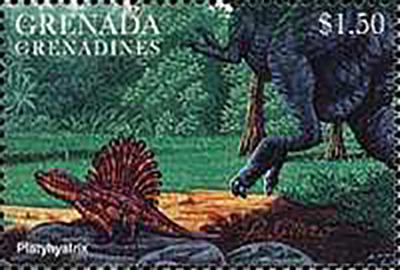Platyhystrix rugosus Case-Williston, 1910-1911

(Da: it.wikipedia.org)
Phylum: Chordata Haeckel, 1874
Subphylum: Vertebrata Cuvier, 1812
Classe: Amphibia Gray 1825
Ordine: Temnospondyli Zittel, 1888
Famiglia: Dissorophidae Boulenger, 1902
Genere: Platyhystrix Williston, 1911
Descrizione
Si tratta di un anfibio che si adattò rapidamente al nuovo clima caldo-umido subentranto dal Carbonifero al Permiano. Molti dei primi rettili che apparvero nel Permiano inferiore, cacciavano il Platyhystrix. Questo, in realtà, non era totalmente indifeso: il suo dorso era ricoperto da una robusta corazza di piastre ossee. L'aspetto di questo anfibio, lungo meno di un metro, era davvero strano: le vertebre dorsali erano straordinariamente allungate, e con tutta probabilità andavano a reggere, nell'animale in vita, una spettacolare vela acuminata e ricoperta di pelle; questa struttura, forse, aveva le funzioni di termoregolazione corporea, e altri animali vissuti nello stesso ambiente, come i pelicosauri Dimetrodon e Edaphosaurus, erano dotati di una simile “vela dorsale”, che serviva, appunto, a catturare il calore solare mattutino, grazie al quale si riscaldava e si manteneva attivo; in questo modo il Platyhystrix, era in grado di muoversi in tempo quando i suoi nemici, come l'Eryops, erano ancora freddi e poco attivi. Il dorso del Platyhystrix era ricoperto inoltre da una spessa corazza, simile a quella del suo stretto parente, il Cacops. Il cranio era grosso e robusto ed il corpo era compatto. Le zampe, corte e forti, denotano un adattamento alla vita terrestre. Da alcuni dei primi anfibi, si svilupparono gli antenati delle rane e dei rospi odierni. Il Platyhystrix, infatti, aveva muso e zampe simili a quelle di una rana.
Diffusione
Anfibio estinto, vissuto nel Permiano inferiore, circa 300-280 milioni di anni fa. I suoi resti sono stati rinvenuti nel Texas.
Sinonimi
= Zatrachys apicalis Case, 1910.
Bibliografia
–Case, E.C. (1910). "New or little known reptiles and amphibians from the Permian (?) of Texas". Bulletin of the American Museum of Natural History. 28: 163-181.
–Berman, David S.; Reisz, Robert R.; Fracasso, Michael A. (1981-12-18). "Skull of the Lower Permian dissorophid amphibian Platyhysthx mgosiis". Annals of the Carnegie Museum. 50: 391-416.
–Vaughn, Peter Paul (1962). "Vertebrates from the Halgaito Tongue of the Cutler Formation, Permian of San Juan County, Utah". Journal of Paleontology. 36 (3): 529-539.
–Atkins, Jade B.; Reisz, Robert R.; Maddin, Hillary C. (2019-03-22). "Braincase simplification and the origin of lissamphibians".
–Schoch, Rainer R. (August 2012). "Character distribution and phylogeny of the dissorophid temnospondyls". Fossil Record. 15 (2): 121-137.
–Williston, Samuel Wendell (1911). American Permian vertebrates. Chicago, Ill.: The University of Chicago Press.
–"I. The structure, evolution and origin of the amphibia. - The "orders' rachitomi and stereospondyli". Philosophical Transactions of the Royal Society of London. Series B, Containing Papers of a Biological Character. 209 (360-371): 1-73.
–Williston, S.W. (1916). "Synopsis of the American Permo-Carboniferous Tetrapoda". Contributions of the Walker Museum. 1: 193-236.
–"The Dog Days of Dissorophids, Week 3: Platyhystrix". Bryan Gee, Ph.D.
–Lewis, G.E.; Vaughn, P.P.; Baird, Donald (1965). "Early Permian vertebrates from the Culter Formation of the Placerville area, Colorado, with a section on footprints from the Cutler Formation". Professional Paper.
–Vaughn, Peter Paul (1971). "A Platyhystrix-like Amphibian with Fused Vertebrae, from the Upper Pennsylvanian of Ohio". Journal of Paleontology. 45 (3): 464-469.
–Bowler, Neven; Sumida, Stuart S.; Huttenlocker, Adam K. (2022-12-21). "Histological evidence for dermal-endochondral co-ossification of the dorsal blades in the late Paleozoic amphibian Platyhystrix rugosus (Temnospondyli: Dissorophidae)". Journal of Vertebrate Paleontology. 42 (2).
–Lucas, Spencer G.; Krainer, Karl; Voigt, Sebastian; Berman, David S.; Henrici, Amy (2014). "The Lower Permian Abo Formation in the northern Sacramento Mountains, southern New Mexico". Geology of the Sacramento Mountains Region. New Mexico Geological Society: 287-302.
–Palmer, D., ed. (1999). The Marshall Illustrated Encyclopedia of Dinosaurs and Prehistoric Animals. London: Marshall Editions. p. 52.
–Mack, Greg H. (2003). "Lower Permian terrestrial Paleoclimatic indicators in New Mexico and their comparison to paleoclimate models". Geology of the Zuni Plateau. New Mexico Geological Society: 231-240.
–DiMichele, William A.; Aronson, Richard B. (June 1992). "The Pennsylvanian-Permian Vegetational Transition: A Terrestrial Analogue to the Onshore-Offshore Hypothesis". Evolution. 46 (3): 807.
–De Mar, Robert Eugene (1966). The phylogenetic and functional implications of the armor of the Dissorophidae / Robert E. DeMar --. [Chicago]: Field Museum of Natural History.
–Carroll, Robert L. (1964). Early evolution of the dissorophid amphibians. The Museum. OCLC 4425765.

|
Data: 15/04/1997
Emissione: Animali preistorici Stato: Grenada and the Grenadines |
|---|